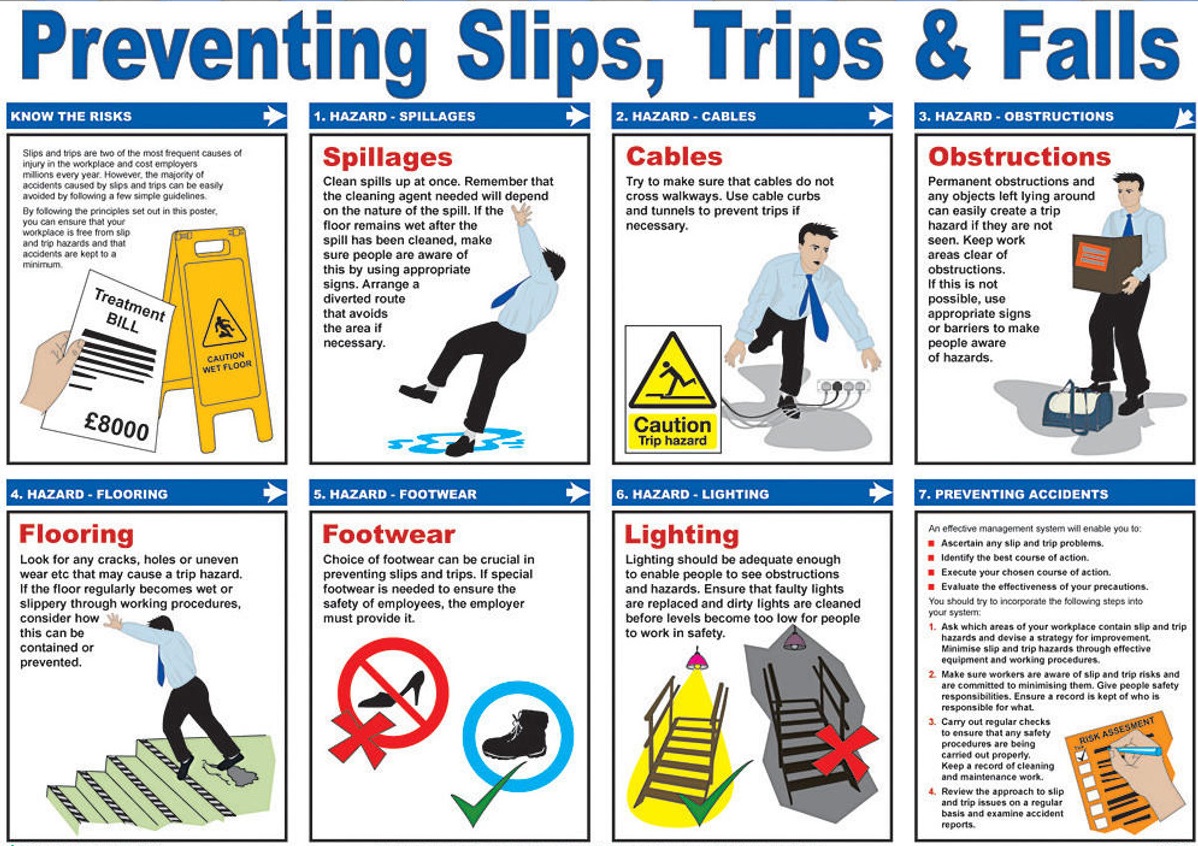This risk assessment is applicable for all kind of operations including the use of tools and equipment’s.
Scope of the document is all locations including sites, offices, stores, workshops, canteens, dry rooms, toilets etc. For all type of work activities at the same level within the working environment including platforms.
Hazards include:
- Cuts and Abrasions
- Laceration
- Serious bodily injury
- Amputation
- Death
Control Measures / Prevention Methods
Ensure routes are kept clean and clear.
Remove rubble, waste and other materials from access/task routes.
Use designated routes to and from workplace.
Site tidiness maintained by cleaning up during work, at end of day (major) weekly to avoid slips and trips.
Assess areas to ensure safe access e.g. those false doors are secured, work machinery for oil leaks etc.
Avoid walking through areas where surface isn’t fully visible e.g. Covered in floor protection, pooling of water‐ risk of opes being covered.
Vigilance from employees as to the risks from slips trips and falls.
No protruding nails allowed: all such nails must be clawed out or hammered flat.
All extension leads / electric cables must be suspended safely in areas and/or laid as not to obstruct access/egress paths etc.
Method of working clearly outlined including scope, routes and housekeeping.
Ensure boots are kept clean and free of mud, oil, grease, use anti static, oil resistance safety boots. Keep footwear as clean as possible.
Ensure ladders are set on solid ground, away from other obstructions.
Consider weather conditions when working/assessing roofs, scaffolding and roadways.
Tidy up area after each task.
Never block access/egress routes with materials equipment.
Inform all employees of access/egress routes and any changes to these throughout the course of the project.
Appropriate PPE personal protective equipment to be worn as per the site rules and regulations.

Access and Egress Risk Assessment
Below are the risks associated with access egress on a construction site:
- Vehicle Movement
- Trips
- Falls
- Collisions
- Injuries including cuts to feet etc.
Control Measures for Access and Egress
Provide clearly marked and safe routes for pedestrians on site.
Inform all employees of access routes and any changes to these throughout the course of the project.
Securely barrier, sign, plate or backfill excavations.
Position unloading areas to avoid reversing.
Provide separate pedestrian and vehicle access where possible.
Plan all lifting operations to avoid lifting over others.
Keep emergency routes clear.
Provide large warning signs and suitable lighting.
Adequate night protection: site lighting, plant immobilized.
Ensure emergency services have suitable access.
Immobile site transport when not in use.
Accompany authorized visitors.
Prohibit unauthorized people and children from entering the site.
Erect suitable hoarding/fencing and warning signs to keep public and children out.
Have controlled entry onto site. Security man at gates if necessary.
Keep walkways clean.
Provide vehicle reversing alarms and banksman.
It is vital that all fire escape doors are not obstructed at any time.
Ensure that temporary roads are a sufficient standard to support emergency vehicle access, including clear definition of the road edges.
All personnel to wear site standard PPE at all times.
Material Storage and Delivery’s Risk Assessment
This risk assessment is applicable for all locations, sites, offices, workshops, canteens, drying rooms, toilets etc. For all types of work activities within the working environment. Stores and lay down areas. Containers, shelving, mechanical lifting aids, bunds, signage, SDS, cages, locks.
Control Measures
Ensure that minimum quantities of materials supplied to the site in line with the programmed works, thus reducing quantities of materials stored which prevent unnecessary damage.
All material will be stored in site stores.
Ensure delivered material is correctly packaged e.g. Drums in good condition, bales uni‐strut, pipes, containment etc. are correctly bound.
Return or make safe any materials incorrectly packaged.
Deliveries will be scheduled at agreed times during normal working hours.
Delivery drivers must be accompanied by inducted personnel.
Ensure that all material storage areas are level and stable.
Follow manufacturer’s recommendations with respect to stacking requirements.
For hazardous materials, MSDS Safety Data Sheets must be available.
Palletized loads should not exceed two pallets in height.
Loads must be lifted correctly, manual handling information and training to be provided to employees.
Store heavy/awkward loads on bottom/middle shelf. Only store light manageable loads at height.
Whenever practicable mechanical lifting/ delivery equipment to be provided minimizing manual handling.
Stacks of cylindrical objects such as pipes, cable drums to be stabilized using chocks etc.
Material stacks should be limited in height to ensure stability, no more than 2meter height.
Drums and containers must be clearly marked to indicate contents.
Secured storage must be provided for all hazardous materials to prevent unauthorized access.
Trays or bunds shall be provided where necessary beneath containers to prevent ground contamination.
Guardrails will be fitted to storage areas where persons could fall.
Hazardous materials e.g. highly flammable liquids, explosives should be stored separately and their issue to be controlled.
Deliveries by HIAB should be monitored and controlled and all lifting operations should not pass over personnel, plant and equipment or accommodation.
Access routes must be kept clean and clear.
Ensure good housekeeping practices are maintained.
Always follow clean as you go policy.
Discover more from Project Management 123
Subscribe to get the latest posts sent to your email.